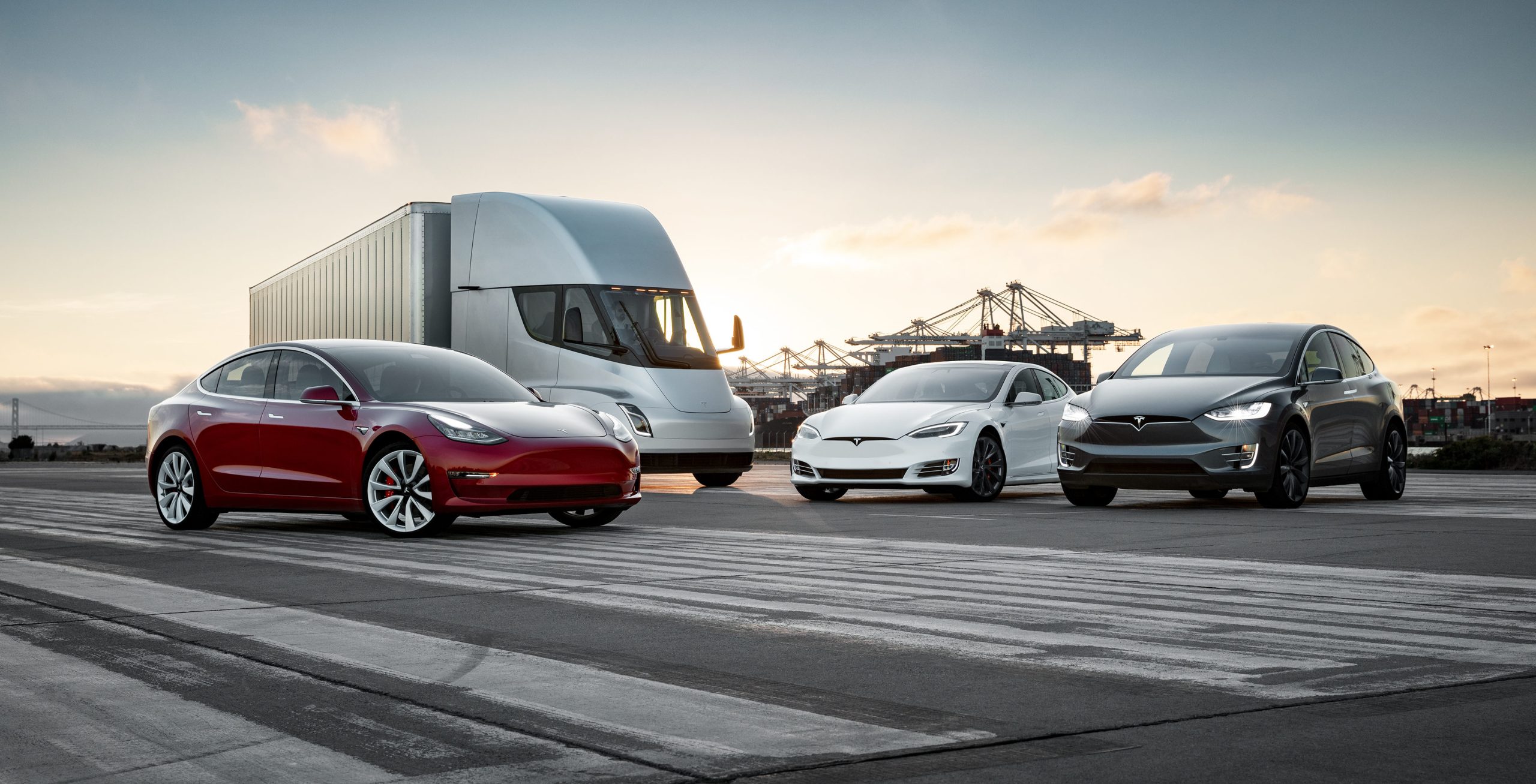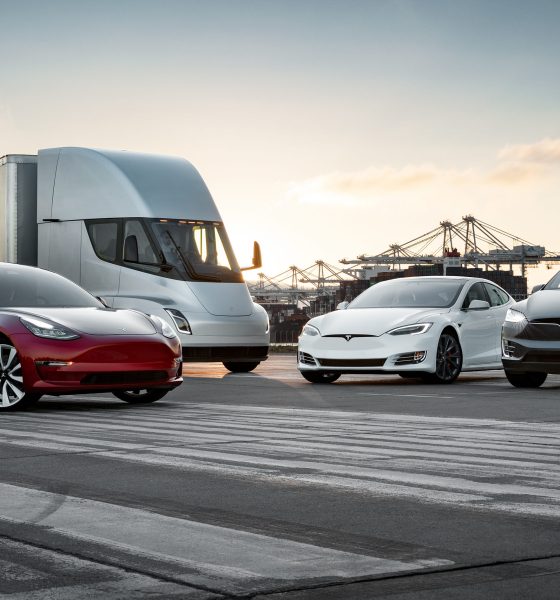

News
Tesla is mainly responsible for the growth of the US’ EV market share, says study
There are several notable companies making all-electric vehicles, but among them, Tesla remains the undisputed leader when it comes to raising awareness for EVs. This was recently reflected in a study from Atlanta-based Cox Automotive, which surveyed 2,503 consumers comprised of electric car owners, EV considerers and EV non-considerers, as well as 308 franchised dealers, to determine the gap between consumers’ and dealers’ barriers and expectations with the current EV realities in the United States.
Based on the results of the study, 81% of car buyers who were open to acquiring an electric car listed Tesla as a vehicle that they were considering for purchase. The gap between Tesla and veteran automakers is notable, with the second place, Toyota, far behind at 52%. Chevrolet was listed by 47% of potential EV buyers, Nissan was listed by 42%, and Honda was listed by a mere 39% of EV considerers.
In a conference call with reporters, Cox Automotive Mobility Group manager of Research & Market Intelligence Rachelle Petusky credited Tesla for positioning itself as a key leader in the electric vehicle market. “They’ve done a wonderful job at presenting themselves as the innovative leader of electric vehicles and therefore, this is translating high awareness among consumers,” she said.
Petusky even went so far as to state that without Tesla in the picture, the market share for electric cars in the United States is “stagnant.” This was despite the alleged impending arrival of dozens upon dozens of electric and electrified vehicles from traditional carmakers.
While Tesla remains a dominating force in the pure electric car segment, Cox’s study also showed that a notable portion car buyers still have reservations about EVs as a whole. Among the respondents who identified themselves as EV Non-Considerers, 83% listed battery limitations and charging anxiety while 70% listed high costs as their barriers to purchasing an electric car. This, according to Petusky, is unfortunate, as EV pricing has actually increased far less than the price of internal combustion cars over the past years.
“EV pricing has only minimally increased in the last 7 years while pricing for new internal combustion engine vehicles has spiked almost 19%. This affordability gap, as it closes, is one of the key areas of educational opportunities for both dealers and OEMS to help consumers to understand what is really a valid option for them,” she said.
Misconceptions about battery longevity are also abounding. Even among respondents who are considering an electric car purchase, 50% viewed the average battery life of EVs at 100,000 miles or more, while 46% stated that they believe the average battery life of an EV was only 65,000 miles or less. In comparison, Consumer Reports notes that the expected lifespan of an internal combustion engine is about 200,000 miles.
Quite interestingly, dealers who participated in the survey admitted that they are experiencing operational challenges in pushing EV sales. Apart from vehicle costs and battery longevity, 55% of dealers reported a lack of inventory and available models as difficulties, while 54% stated that they see lower ROI for EVs compared to internal combustion cars. A third of the dealers in the study also pointed to the lack of OEM sales, marketing support, and poor sales training as a challenge for more electric car sales. Only 9% of dealers stated that carmakers are exerting pressure to hit EV sales targets as well.
Cox Automotive’s full press release on its recent EV study could be found here.

News
Tesla FSD fleet is nearing 7 billion total miles, including 2.5 billion city miles
As can be seen on Tesla’s official FSD webpage, vehicles equipped with the system have now navigated over 6.99 billion miles.

Tesla’s Full Self-Driving (Supervised) fleet is closing in on almost 7 billion total miles driven, as per data posted by the company on its official FSD webpage.
These figures hint at the massive scale of data fueling Tesla’s rapid FSD improvements, which have been quite notable as of late.
FSD mileage milestones
As can be seen on Tesla’s official FSD webpage, vehicles equipped with the system have now navigated over 6.99 billion miles. Tesla owner and avid FSD tester Whole Mars Catalog also shared a screenshot indicating that from the nearly 7 billion miles traveled by the FSD fleet, more than 2.5 billion miles were driven inside cities.
City miles are particularly valuable for complex urban scenarios like unprotected turns, pedestrian interactions, and traffic lights. This is also the difference-maker for FSD, as only complex solutions, such as Waymo’s self-driving taxis, operate similarly on inner-city streets. And even then, incidents such as the San Francisco blackouts have proven challenging for sensor-rich vehicles like Waymos.
Tesla’s data edge
Tesla has a number of advantages in the autonomous vehicle sector, one of which is the size of its fleet and the number of vehicles training FSD on real-world roads. Tesla’s nearly 7 billion FSD miles then allow the company to roll out updates that make its vehicles behave like they are being driven by experienced drivers, even if they are operating on their own.
So notable are Tesla’s improvements to FSD that NVIDIA Director of Robotics Jim Fan, after experiencing FSD v14, noted that the system is the first AI that passes what he described as a “Physical Turing Test.”
“Despite knowing exactly how robot learning works, I still find it magical watching the steering wheel turn by itself. First it feels surreal, next it becomes routine. Then, like the smartphone, taking it away actively hurts. This is how humanity gets rewired and glued to god-like technologies,” Fan wrote in a post on X.
News
Tesla starts showing how FSD will change lives in Europe
Local officials tested the system on narrow country roads and were impressed by FSD’s smooth, human-like driving, with some calling the service a game-changer for everyday life in areas that are far from urban centers.

Tesla has launched Europe’s first public shuttle service using Full Self-Driving (Supervised) in the rural Eifelkreis Bitburg-Prüm region of Germany, demonstrating how the technology can restore independence and mobility for people who struggle with limited transport options.
Local officials tested the system on narrow country roads and were impressed by FSD’s smooth, human-like driving, with some calling the service a game-changer for everyday life in areas that are far from urban centers.
Officials see real impact on rural residents
Arzfeld Mayor Johannes Kuhl and District Administrator Andreas Kruppert personally tested the Tesla shuttle service. This allowed them to see just how well FSD navigated winding lanes and rural roads confidently. Kruppert said, “Autonomous driving sounds like science fiction to many, but we simply see here that it works totally well in rural regions too.” Kuhl, for his part, also noted that FSD “feels like a very experienced driver.”
The pilot complements the area’s “Citizen Bus” program, which provides on-demand rides for elderly residents who can no longer drive themselves. Tesla Europe shared a video of a demonstration of the service, highlighting how FSD gives people their freedom back, even in places where public transport is not as prevalent.
What the Ministry for Economic Affairs and Transport says
Rhineland-Palatinate’s Minister Daniela Schmitt supported the project, praising the collaboration that made this “first of its kind in Europe” possible. As per the ministry, the rural rollout for the service shows FSD’s potential beyond major cities, and it delivers tangible benefits like grocery runs, doctor visits, and social connections for isolated residents.
“Reliable and flexible mobility is especially vital in rural areas. With the launch of a shuttle service using self-driving vehicles (FSD supervised) by Tesla in the Eifelkreis Bitburg-Prüm, an innovative pilot project is now getting underway that complements local community bus services. It is the first project of its kind in Europe.
“The result is a real gain for rural mobility: greater accessibility, more flexibility and tangible benefits for everyday life. A strong signal for innovation, cooperation and future-oriented mobility beyond urban centers,” the ministry wrote in a LinkedIn post.
News
Tesla China quietly posts Robotaxi-related job listing
Tesla China is currently seeking a Low Voltage Electrical Engineer to work on circuit board design for the company’s autonomous vehicles.

Tesla has posted a new job listing in Shanghai explicitly tied to its Robotaxi program, fueling speculation that the company is preparing to launch its dedicated autonomous ride-hailing service in China.
As noted in the listing, Tesla China is currently seeking a Low Voltage Electrical Engineer to work on circuit board design for the company’s autonomous vehicles.
Robotaxi-specific role
The listing, which was shared on social media platform X by industry watcher @tslaming, suggested that Tesla China is looking to fill the role urgently. The job listing itself specifically mentions that the person hired for the role will be working on the Low Voltage Hardware team, which would design the circuit boards that would serve as the nervous system of the Robotaxi.
Key tasks for the role, as indicated in the job listing, include collaboration with PCB layout, firmware, mechanical, program management, and validation teams, among other responsibilities. The role is based in Shanghai.
China Robotaxi launch
China represents a massive potential market for robotaxis, with its dense urban centers and supportive policies in select cities. Tesla has limited permission to roll out FSD in the country, though despite this, its vehicles have been hailed as among the best in the market when it comes to autonomous features. So far, at least, it appears that China supports Tesla’s FSD and Robotaxi rollout.
This was hinted at in November, when Tesla brought the Cybercab to the 8th China International Import Expo (CIIE) in Shanghai, marking the first time that the autonomous two-seater was brought to the Asia-Pacific region. The vehicle, despite not having a release date in China, received a significant amount of interest among the event’s attendees.








